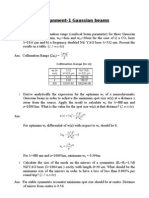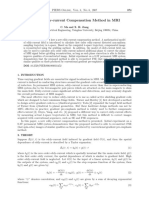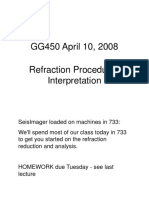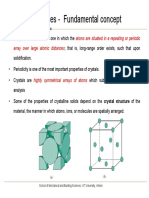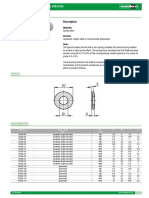Professional Documents
Culture Documents
Topic Take-Off Angle Calculations For Fault-Plane Solutions and Reconstruction of Nodal Planes From The Parameters of Fault-Plane Solutions
Topic Take-Off Angle Calculations For Fault-Plane Solutions and Reconstruction of Nodal Planes From The Parameters of Fault-Plane Solutions
Uploaded by
Francisco JavierOriginal Description:
Original Title
Copyright
Available Formats
Share this document
Did you find this document useful?
Is this content inappropriate?
Report this DocumentCopyright:
Available Formats
Topic Take-Off Angle Calculations For Fault-Plane Solutions and Reconstruction of Nodal Planes From The Parameters of Fault-Plane Solutions
Topic Take-Off Angle Calculations For Fault-Plane Solutions and Reconstruction of Nodal Planes From The Parameters of Fault-Plane Solutions
Uploaded by
Francisco JavierCopyright:
Available Formats
Exercise EX 3.
3
1
Topic Take-off angle calculations for fault-plane solutions and
reconstruction of nodal planes from the parameters of fault-
plane solutions
Author Peter Bormann (formerly GFZ German Research Centre for Geosciences,
14473 Potsdam, Germany); E-mail: pb65@gmx.net
Version September 1999; DOI: 10.2312/GFZ.NMSOP-2_EX_3.3
1 Aim
The exercise aims at making familiar with the calculation of the take-off angles AIN of
seismic P-wave rays leaving the seismic source towards the seismic station. These angles are
required for determining fault-plane solutions (FPS) from first-motion polarity readings (see
EX 3.2). Take-off angles depend on the velocity model of the Earth, the source depth h and
the epicentral distance . at which the considered rays arrive at the Earths surface. The AIN
calculated in this exercise for a given event and a number of seismic stations at different
will then be checked whether they are consistent with the reported polarity readings and FPS
calculated for this event by international agencies. For this you will reconstruct on a Lambert-
Schmidt net projection the fault-plane traces from the reported nodal-plane parameters.
2 Data, models and procedure
When localizing near events by using HYPO71 or similar programs the values for both the
azimuth (AZM) and for the take-off angles (AIN) of the rays leaving the source towards the
considered stations are given in the localization output file. One can use them, together with
the first motion polarity readings, straight forward for the determination of fault-plane
solutions (see EX 3.2). When one intends to determine the fault-plane solution for seismic
events published in the bulletins of the International Seismological Centre (ISC) one finds
therein, besides data for polarity readings from the reporting stations ( or c for up and or d
for down in short- or long-period instruments, respectively), only values for the azimuth
(AZM) but not for the respective take-off angle (AIN). Figure 1 shows a typical portion of
event-stations report from the ISC. Its header also gives the seismic moment tensor and fault-
plane solutions calculated by various international data centers or agencies using different
(sometimes automated) procedures. Values for AIN can be calculated by using the
relationship
sin AIN = (180/) (v
P
/r
h
) p(, h). (1)
v
P
(h) is the P-wave velocity at the depth h (in km/s), r
o
=6371 km is the Earths radius and r
h
=r
o
- h. p(, h) =dT/d is the ray parameter; it corresponds to the gradient of the travel-time
curve at the point of observation on the Earths surface (both in units s/deg) at the epicentral
distance (in degree) (see Fig. 2.27) and is a function of the hypocentral depth h (in km). The
value of the ray parameter is identical with that of the horizontal component of the of the
slowness vector. Tables 1 and 2 give the respective values v
P
(h) and p(, h) for P waves.
Exercise EX 3.3
2
Table 1 v
P
(h) according to the IASPEI91 velocity model (Kennett, 1991).
h (km) v
P
(km/s) h (km) v
P
(km/s) h (km) v
P
(km/s)
0
20
20
35
35
71
120
5.8000
5.8000
6.5000
6.5000
8.0400
8.0442
8.0500
120
171
210
271
371
410
410
8.0500
8.1917
8.3000
8.5227
8.8877
9.0300
9.3600
471
571
660
660
671
760
9.5650
9.9010
10.2000
10.7900
10.8192
11.0558
Table 2 Ray parameter p =dT/d (=horizontal slowness component) of Pn, P and PKP
df
first arrivals at the Earths surface as a function of hypocentral depth h according to IASPEI
1991 Seismological Tables (Kennett, 1991)
p (in s/deg)
Phase (in deg) h =0 km h =100 km h =300 km h =600 km
Pn (P)
P
2
4
6
8
10
12
14
16
18
20
22
24
26
28
30
32
34
36
38
40
42
44
46
48
50
52
54
56
58
60
62
13.75
13.75
13.74
13.72
13.70
13.67
13.64
12.92
12.33
10.90
10.70
9.14
9.06
8.93
8.85
8.77
8.67
8.56
8.44
8.30
8.17
8.03
7.89
7.55
7.60
7.46
7.31
7.17
7.02
6.88
6.73
12.90
13.49
13.58
13.60
13.59
13.29
12.91
12.43
10.97
10.81
10.58
9.11
9.02
8.90
8.82
8.74
8.64
8.52
8.40
8.26
8.13
7.99
7.85
7.71
7.56
7.42
7.28
7.13
6.99
6.84
6.70
7.91
10.96
11.95
12.25
12.26
12.12
11.03
10.91
10.73
10.50
9.12
9.03
8.91
8.83
8.75
8.65
8.54
8.42
8.29
8.16
8.03
7.89
7.75
7.61
7.47
7.33
7.19
7.05
6.90
6.76
6.62
4.01
6.91
8.60
9.48
9.90
10.05
10.06
9.17
9.10
9.02
8.90
8.83
8.76
8.66
8.56
8.45
8.33
8.21
8.08
7.95
7.82
7.69
7.56
7.42
7.29
7.15
7.02
6.88
6.74
6.61
6.47
Exercise EX 3.3
3
Table 2: cont.
p (in s/deg)
Phase (in deg) h =0 km h =100 km h =300 km h =600 km
P
P
diff
PKP
df
64
66
68
70
72
74
76
78
80
82
84
86
88
90
92
94
96
98
100-144
114
116-122
124-126
130
136
140
142
144
146
148
150
152
154
156
158
160
162
164
166
168
170
172
174
176
178
180
6.59
6.44
6.30
6.15
6.00
5.86
5.71
5.56
5.40
5.25
5.09
4.94
4.74
4.66
4.61
4.58
4.52
4,45
4.44
1.92
1.91
1.90
1.88
1.84
1.80
1.76
1.73
1.68
1.63
1.57
1.49
1.42
1.33
1.24
1.14
1.04
0.93
0.82
0.71
0.59
0.47
0.36
0.24
0.12
0.00
6.55
6.41
6.27
6.12
5.97
5.83
5.68
5.53
5.38
5.22
5.07
4.92
4.72
4.65
4.61
4.57
4.51
4.44
4.44
1.92
1.91
1.90
1.88
1.84
1.79
1.76
(1.72)
1.68
1.62
1.56
1.49
1.41
1.33
1.23
1.14
1.03
0.93
0.82
0.70
0.59
0.47
0.36
0.24
0.12
0.00
6.48
6.33
6.19
6.05
5.90
5.76
5.61
5.46
5.31
5.16
5.01
4.85
4.69
4.64
4.60
4.55
4.49
4.44
4.44
1.92
1.91
1.90
1.88
1.84
1.79
1.76
(1.72)
1.67
1.62
1.55
1.48
1.40
1.32
1.23
1.13
1.03
0.92
0.81
0.70
0.58
0.47
0.35
0.24
0.12
0.00
6.33
6.19
6.05
5.91
5.77
5.63
5.49
5.34
5.20
5.04
4.90
4.72
4.65
4.61
4.57
4.51
4.44
4.44
4.44
1.92
1.91
1.90
1.88
1.83
1.78
1.75
(1.71)
1.66
1.60
1.54
1.47
1.39
1.30
1.21
1.11
1.01
0.91
0.80
0.69
0.58
0.47
0.35
0.23
0.12
0.00
Exercise EX 3.3
4
NEIC Moment-tensor solution: s23, scale 10
17
Nm; M
rr
-3.05;
M
-0.97; M
4.03; M
r
-2.51; M
r
-1.95; M
2.71. Depth
272km; Principal axes: T 6.09, Plg17, Azm117; N -136,
Plg27, Azm216; P -4.73, Plg57, Azm358; Best double
couple: M
o
5.4x10
17
Nm; NP1:
s
172, 36, -140. NP2:
s
48, 68, -60.
HRVD 05
d
13
h
24
m
15
s
.70
s
.2, 39.10N.02x15.39E.02,
h295
km
.8
km
, Centroid moment-tensor solution. Data used:
GDSN; LP body waves: s50, c**; Half duration: 1
s
.9.
Moment tensor: Scale 10
17
Nm; M
rr
-2.17.06;
M
-1.97.10; M
4.14.09; M
r
-3.51.09; M
r
--3.29.09;
M
0.01.09. Principal Axes: T 5.83, Plg27, Azm103;
N 0.32, Plg30, Azm210; P -6.15, Plg48, Azm339. Best
Double couple: M
o
6.0x10
17
Nm, NP1:
s
146, 33, -157.
NP2:
s
37, 78, -60.
ISC 05
d
13
h
24
m
11
s
.40
s
.13, 39.160
s
.16x15.18E.014,
h290
km
1.3
km
, (h286km2.7
km
:pP-P), n757, 1
s
.04/729,
Mb5.7/107, 119C-155D, Southern Italy.
OVO Vesuviano 1.77 340 iP 13 24 57.2 +1.5
MCT Mte Cammarata 1.95 219 P 13 24 57.7 +0.6
FG4 Candela 1.99 8 P 13 24 58.2 +0.9
MEU Monte Lauro 2.07 186 dP 13 24 56.8 -1.3
PZI Palazzolo 2.14 186 eP 13 24 57 -1.7
FAI Favara 2.21 213 dP 13 24 59.5 +0.1
MSC Monte Massico 2.23 336 iP 13 25 01.1 +1.6
SGG Gregorio Matese 2.30 345 iP 13 25 01.9 +1.8
Figure 1 Typical section of an ISC bulletin (left) with NEIC (National Earthquake
Information Center) and Harvard University (HRVD) moment-tensor fault-plane solutions
(right) for the Italy deep earthquake (h =286 km) of J an. 05, 1994. Columns 3 to 5 of the
bulletin give the following data: 3 - epicentral distance in degrees, 4 - azimuth AZM in
degrees, 5 - phase code and polarity.
Table 3 gives respective selected data from the ISC bulletin for five seismic stations at
different epicentral distances () and azimuth (AZM) for the Italy earthquake shown in Figure
1. The polarity readings correspond to the first P ( <100 ) or PKP ( >110 ) onsets.
Table 3
STA
(deg)
AZM
(deg)
POL v
P
(h)
km/s
v
P
/r
h
(s
-1
)
p(,h)
(s/deg)
AIN
(deg)
AZMc
(deg)
AINc
(deg)
SGG
KHC
BTH
ZAK
PAE
2.30
10.03
12.25
60.02
154.8
345
354
294
48
324
+
-
+
-
-
Exercise EX 3.3
5
3 Tasks
Task 1:
For the data given in Table 3, calculate the missing values in the blank columns for v
P
(h),
v
P
/r
h
, p(, h) and AIN using Table 1 and 2 and assuming an approximate focal depth for the
recorded event of h =300 km. Interpolate linearly as a first approximation.
Task 2:
Decide whether your ray has left the upper or lower half of the focal sphere and whether or
not you need to calculate AINc and/or AZMc according to Figs. 3.28 and 3.29 in Chapter 3.
Complete Table 3 accordingly.
Task 3:
Use the values given in Figure 1 for and for the nodal planes NP1 and NP2 of the NEIC
fault-plane solution. Reconstruct both nodal (fault) planes using the Lambert-Schmidt net
(Fig. 3.27b) by applying the procedure inverse to the one described in the Exercise :
Determination of fault-plane solutions (EX 3.2). Compare your nodal-plane pattern with that
of the NEIC "beach-ball" solution (Figure 1 upper right).
Task 4:
Find the corresponding equatorial plane to your NP1 and NP2 and mark the locations of the P
and T axes on the focal sphere. Draw the P and T vectors towards and from the center of the
net, determine their azimuth (Azm) and plunge (Plg) [equivalent to dip, measured from the
horizontal]. Compare your respective values with those given by NEIC in Figure 1.
Task 5:
Use the values that you calculated for the P-wave take-off angle AINc and ray azimuth
AZMc to all 5 stations in Table 3 and mark the point where the ray penetrates the focal sphere
and indicate the respective polarity. Check whether they fall into the proper T and P quadrants
and whether the short-period polarity readings given in Table 3 are consistent with the fault-
plane solution published by the NEIC which is based on long-period waveform data.
4 Solutions and discussions
Table 4 Solutions for Task 1.
STA
(deg)
AZM
(deg)
POL v
P
(h)
km/s
v
P
/r
h
(s
-1
)
p(,h)
(s/deg)
AIN
(deg)
AZMc
(deg)
AINc
(deg)
SGG
KHC
BTH
ZAK
PAE
2.30
10.03
12.25
60.02
154.8
345
354
294
48
324
+
-
+
-
-
8.6286
1.4213
10
-3
8.368
12.258
11.984
6.759
1.368
(137.0)
86.5
77.4.1
33.4
6.4
165
43.0
Exercise EX 3.3
6
Task 2:
Note: In the case of deep earthquakes the values of the ray parameter (and thus slowness)
may increase with , e.g., in Table 2 for h =300 km up to =10. This corresponds to
seismic rays that leave the source upwards! Consequently, the value AIN =43.0 calculated
with Equation (1) for station SGG corresponds, according to the definition given in Fig. 3.28,
in fact to an angle of 180 - AIN =137.0. Accordingly, AZMc and AINc for the equivalent
lower hemisphere projection of this ray are 345-180 =165 and 43.0, respectively.
Task 3:
Your manually drawn fault-plane solutions should look very similar to that of the NEIC
solution in Figure 1 upper right.
Task 4:
Your manually re-constructed values for Azm and Plg of the P and T axes should agree with
the NEIC solution within a few degrees (<10). If not, check your drawing of the three planes,
of the related P and T axis and the measured angles.
Task 5:
The short-period polarity data used in this exercise are consistent with the fault-plane solution
published by the NEIC which is based on long-period waveform data. All your polarities
should fall properly into quadrants of either observed compressional or dilatational P-wave
first motions.
References
Kennett, B. L. N. (Ed.) (1991). IASPEI 1991 Seismological Tables. Research School of Earth
Sciences, Australian National University, 167 pp.
You might also like
- Lab1 MEE30004 - Lab1 - 2021 Sem2 - Raw DataDocument7 pagesLab1 MEE30004 - Lab1 - 2021 Sem2 - Raw DataAbidul IslamNo ratings yet
- Mech 375 Lab 1Document13 pagesMech 375 Lab 1Patrick Mroczek100% (1)
- Coopertitchener Trifilar1Document30 pagesCoopertitchener Trifilar1api-24490620450% (2)
- Determination of Refractive Indices For A Prism Material and A Given Transparent LiquidDocument9 pagesDetermination of Refractive Indices For A Prism Material and A Given Transparent LiquidAsa mathew100% (8)
- Seismology Problem Set 1 4Document11 pagesSeismology Problem Set 1 4Goldy BanerjeeNo ratings yet
- Laboratory Report 10 (Drag On A Sphere)Document16 pagesLaboratory Report 10 (Drag On A Sphere)Wang WeiXinNo ratings yet
- Coupled PendulumsDocument7 pagesCoupled PendulumsMatthew BerkeleyNo ratings yet
- Solutions For SemiconductorsDocument54 pagesSolutions For SemiconductorsOzan Yerli100% (2)
- Solution Set Seismic Refraction Exercise For Hydrogeology ClassDocument9 pagesSolution Set Seismic Refraction Exercise For Hydrogeology ClassFrancisco JavierNo ratings yet
- Catalog RoboriseIt 2019 05Document60 pagesCatalog RoboriseIt 2019 05Alaas Alvcasza100% (2)
- SATR-W-2006 Rev 6Document1 pageSATR-W-2006 Rev 6Manoj KumarNo ratings yet
- As 2213.1-2001 Commercial Road Vehicles - Mechanical Connections Between Towing Vehicles Selection and MarkinDocument6 pagesAs 2213.1-2001 Commercial Road Vehicles - Mechanical Connections Between Towing Vehicles Selection and MarkinSAI Global - APACNo ratings yet
- Topic Determination of Source Parameters From Seismic SpectraDocument7 pagesTopic Determination of Source Parameters From Seismic SpectraFrancisco JavierNo ratings yet
- Topic Determination of Fault-Plane Solutions by HandDocument17 pagesTopic Determination of Fault-Plane Solutions by HandFrancisco JavierNo ratings yet
- Horizontal Projectile MotionDocument8 pagesHorizontal Projectile MotionInu KagNo ratings yet
- DS 3.1 Rev1Document8 pagesDS 3.1 Rev1w_3385621No ratings yet
- Arm Hovsepyan G Abs2 He12 PosterDocument4 pagesArm Hovsepyan G Abs2 He12 PostergorditoNo ratings yet
- Public Surveying EquationsDocument15 pagesPublic Surveying Equations_dos_7No ratings yet
- Earthquake Location: The Basic PrinciplesDocument40 pagesEarthquake Location: The Basic PrinciplesMohit JhalaniNo ratings yet
- Experiment Hydrogen Atom Spectrum-Lab ReportDocument4 pagesExperiment Hydrogen Atom Spectrum-Lab ReportTapan Kr LaiNo ratings yet
- Pressure Altimetry Using The MPL3115A2: Freescale SemiconductorDocument13 pagesPressure Altimetry Using The MPL3115A2: Freescale SemiconductorvijayaNo ratings yet
- Chapter 8 Matriculation STPMDocument129 pagesChapter 8 Matriculation STPMJue Saadiah100% (7)
- Analysis of Parameters of Ground Vibration Produced From Bench Blasting at A Limestone QuarryDocument6 pagesAnalysis of Parameters of Ground Vibration Produced From Bench Blasting at A Limestone QuarryMostafa-0088No ratings yet
- The Inversion Potential For NH 3 and Its Isotopic Species: Ab InitioDocument6 pagesThe Inversion Potential For NH 3 and Its Isotopic Species: Ab Initiomohammadiarash049No ratings yet
- CH 08Document44 pagesCH 08claudioNo ratings yet
- Source Inversion of The 1988 Upland, CaliforniaDocument12 pagesSource Inversion of The 1988 Upland, CaliforniabuitrungthongNo ratings yet
- Tutorial 7 SolutionDocument8 pagesTutorial 7 SolutionCKNo ratings yet
- Exam Specifications - PS Supplied ReferencesDocument24 pagesExam Specifications - PS Supplied ReferencesDime CeselkoskiNo ratings yet
- Netherlands Geodetic Commission: Publications On Geodesy New SeriesDocument36 pagesNetherlands Geodetic Commission: Publications On Geodesy New SeriesjoaosevanNo ratings yet
- Technique For Estimating Natural FrequenciesDocument4 pagesTechnique For Estimating Natural Frequencies王轩No ratings yet
- Section I Measurement: - Page 3Document6 pagesSection I Measurement: - Page 3Tilak K CNo ratings yet
- Lab &Document6 pagesLab &Muhammad AbdullahNo ratings yet
- 1 PDFDocument9 pages1 PDFalihasan12No ratings yet
- HW Set 1Document6 pagesHW Set 1GsusKrystNo ratings yet
- Jennings Nigam 1969Document14 pagesJennings Nigam 1969berlomorenoNo ratings yet
- 6S操作手册 P2Document83 pages6S操作手册 P2luolanmeiNo ratings yet
- NigamJennings CalResponseSpectra1969 PDFDocument14 pagesNigamJennings CalResponseSpectra1969 PDFAnjani PrabhakarNo ratings yet
- Measurement Tutorial Solutions 2013Document12 pagesMeasurement Tutorial Solutions 2013elmodragonNo ratings yet
- Baumgardner Frederickson 1985Document10 pagesBaumgardner Frederickson 1985Danilo AlexandreNo ratings yet
- Eso208 TutorialDocument5 pagesEso208 TutorialyhjklNo ratings yet
- Deterministic Phase Retrieval: A Green's Function SolutionDocument8 pagesDeterministic Phase Retrieval: A Green's Function Solutionlednakashim100% (1)
- Simultaneous Inversion of PP and PS Wave AVO-AVA Data Using Simulated AnnealingDocument4 pagesSimultaneous Inversion of PP and PS Wave AVO-AVA Data Using Simulated AnnealingTony WalleNo ratings yet
- G - 1 - Gilberto Ruiz - T4Document8 pagesG - 1 - Gilberto Ruiz - T4DANIELA RODRIGUEZNo ratings yet
- 3 Story Seismic AnalysisDocument15 pages3 Story Seismic AnalysisKavita Kaur KamthekarNo ratings yet
- Supercritical Airfoil and CharacteristicsDocument7 pagesSupercritical Airfoil and CharacteristicsABHISHEK MANI TRIPATHINo ratings yet
- 4041-Article Text PDF-7799-1-10-20130718Document13 pages4041-Article Text PDF-7799-1-10-20130718Miloš BasarićNo ratings yet
- Jun 2004 Flow SphereDocument41 pagesJun 2004 Flow SpherehquynhNo ratings yet
- Assignment For LecturesDocument16 pagesAssignment For LecturesDeepak JainNo ratings yet
- Compound Pendulum Lab ReportDocument11 pagesCompound Pendulum Lab ReportSyedlakhtehassan100% (1)
- Phase Difference Between VR and VCDocument32 pagesPhase Difference Between VR and VCMehedi Hassan100% (1)
- Lab 5 InstruLectureDocument13 pagesLab 5 InstruLectureusjpphysicsNo ratings yet
- RichtungsstatistikDocument31 pagesRichtungsstatistikBauschmannNo ratings yet
- Ultrasonic Lamb WaveDocument12 pagesUltrasonic Lamb WaveMohsin IamNo ratings yet
- A Note On The "Implicit" Method For Finite-Difference Heat-Transfer CalculationsDocument2 pagesA Note On The "Implicit" Method For Finite-Difference Heat-Transfer CalculationsMaiman LatoNo ratings yet
- Sardar Vallabhbhai National Institute of Technology, Surat: CAEE ProjectDocument13 pagesSardar Vallabhbhai National Institute of Technology, Surat: CAEE ProjectNimesh AgrawalNo ratings yet
- Multi-Planar Image Formation Using Spin Echoes: Letter To The EditorDocument4 pagesMulti-Planar Image Formation Using Spin Echoes: Letter To The EditorEdward Ventura BarrientosNo ratings yet
- QP GeolM 23 GEO PHYSICS PAPER II 250623Document13 pagesQP GeolM 23 GEO PHYSICS PAPER II 250623Arvind sharmaNo ratings yet
- Corrientes de EddyDocument5 pagesCorrientes de EddyHarley Alejo MNo ratings yet
- InvolutDocument24 pagesInvolutal_mmDNo ratings yet
- Time Domain Transient Analysis of Electromagnetic Field Radiation For Phased Periodic Array Antennas ApplicationsDocument4 pagesTime Domain Transient Analysis of Electromagnetic Field Radiation For Phased Periodic Array Antennas Applicationspetrishia7_317164251No ratings yet
- Computer Processing of Remotely-Sensed Images: An IntroductionFrom EverandComputer Processing of Remotely-Sensed Images: An IntroductionNo ratings yet
- Ix Ix Ix Ix Ix A D Ix A D: KX A A ADocument3 pagesIx Ix Ix Ix Ix A D Ix A D: KX A A AFrancisco JavierNo ratings yet
- GG450 April 10, 2008 Refraction Procedures InterpretationDocument24 pagesGG450 April 10, 2008 Refraction Procedures InterpretationFrancisco JavierNo ratings yet
- Love The Way You Lie (Parte II)Document1 pageLove The Way You Lie (Parte II)Francisco JavierNo ratings yet
- Reflex 2 D QuickDocument61 pagesReflex 2 D QuickFrancisco JavierNo ratings yet
- Though Chemical Processes Are by Far The Most Important. A Brief SiimDocument2 pagesThough Chemical Processes Are by Far The Most Important. A Brief SiimFrancisco JavierNo ratings yet
- Lecture 3Document10 pagesLecture 3Abhishek SinhaNo ratings yet
- Saep-324 2018 PDFDocument23 pagesSaep-324 2018 PDFAdnan Rafiq100% (1)
- VenturimeterDocument24 pagesVenturimeterYashArnatNo ratings yet
- NGVA Europe Position Paper On LNGDocument20 pagesNGVA Europe Position Paper On LNGpriyoNo ratings yet
- 02 GSM BSS Network KPI (SDCCH Call Drop Rate) Optimization ManualDocument26 pages02 GSM BSS Network KPI (SDCCH Call Drop Rate) Optimization ManualMistero_H100% (3)
- Tyco Pressure Relief Valve Engineering Handbook (Tyco Flow Control, 2012)Document232 pagesTyco Pressure Relief Valve Engineering Handbook (Tyco Flow Control, 2012)gfgf100% (2)
- Installation DS NOCDocument19 pagesInstallation DS NOCPatrice TanoNo ratings yet
- Master Parts Hale Doble ViaDocument45 pagesMaster Parts Hale Doble ViaJonathanDavidDeLosSantosAdornoNo ratings yet
- Enerpac BHP Series Catalog SetsDocument3 pagesEnerpac BHP Series Catalog SetsTitanplyNo ratings yet
- MT4400 Front Brakes (Carlisle)Document15 pagesMT4400 Front Brakes (Carlisle)Brian CareelNo ratings yet
- Management Information SystemDocument12 pagesManagement Information Systemlilashcoco83% (6)
- GeopressureDocument1 pageGeopressurePromoservicios CANo ratings yet
- Werkzeug DocsDocument245 pagesWerkzeug DocseviroyerNo ratings yet
- Crystal StructuresDocument54 pagesCrystal StructuresyashvantNo ratings yet
- Sdm-Aict P-N Fab. Flow ChartDocument18 pagesSdm-Aict P-N Fab. Flow ChartMohit BoliwalNo ratings yet
- Baillie House - Case Study - Knauf InsulationDocument2 pagesBaillie House - Case Study - Knauf InsulationJhay SalvatierraNo ratings yet
- Din 6796Document2 pagesDin 6796VijayGowthaman0% (1)
- EOI - Tanzania - Carrying Out Feasibility Study Detailed Engineering Design and Preparation of Tender DocumentsDocument2 pagesEOI - Tanzania - Carrying Out Feasibility Study Detailed Engineering Design and Preparation of Tender DocumentsArden Muhumuza KitomariNo ratings yet
- Biological TreatmentDocument76 pagesBiological Treatmentanhtuan66No ratings yet
- Mazda - 5 - Engine - Workshop - Manual - l8 - LF l3 - 0202200725Document1 pageMazda - 5 - Engine - Workshop - Manual - l8 - LF l3 - 0202200725info.tf.montNo ratings yet
- Question Paper:: Eighth Engineenng ANDDocument2 pagesQuestion Paper:: Eighth Engineenng ANDananthaaNo ratings yet
- D ManCivil4thsemTTDocument253 pagesD ManCivil4thsemTTsathishNo ratings yet
- Course Start Instructor Task Lists Checklist Blackboard Updated 04-17-14Document2 pagesCourse Start Instructor Task Lists Checklist Blackboard Updated 04-17-14api-253788866No ratings yet
- Lecture No. 5 Phase DiagramDocument32 pagesLecture No. 5 Phase DiagramarslanNo ratings yet
- Vitalograph®Document2 pagesVitalograph®Basheer MohamedNo ratings yet
- Partisol 2000i Air SamplerDocument2 pagesPartisol 2000i Air SamplerArana YupanquiNo ratings yet
- Quotation of Vacuum Lifter GL-LD Series - QingdaoSinofirst 1801204Document6 pagesQuotation of Vacuum Lifter GL-LD Series - QingdaoSinofirst 1801204leo limpiasNo ratings yet
















































